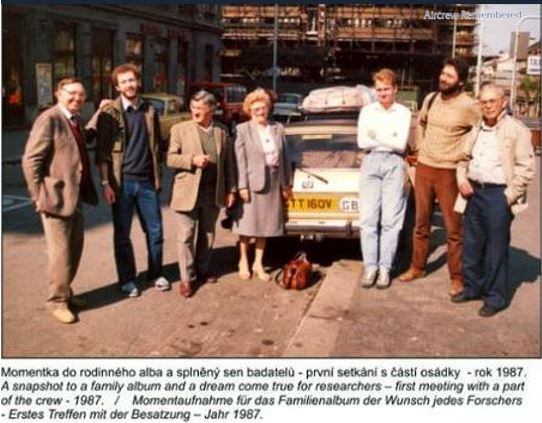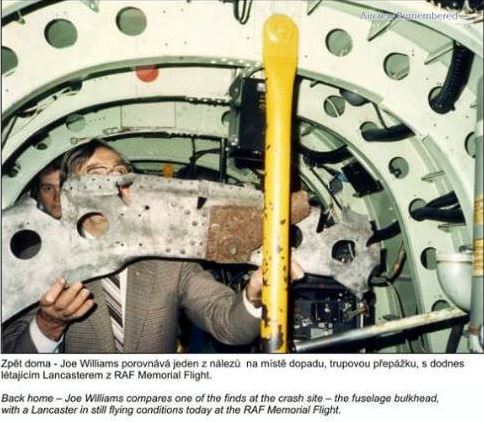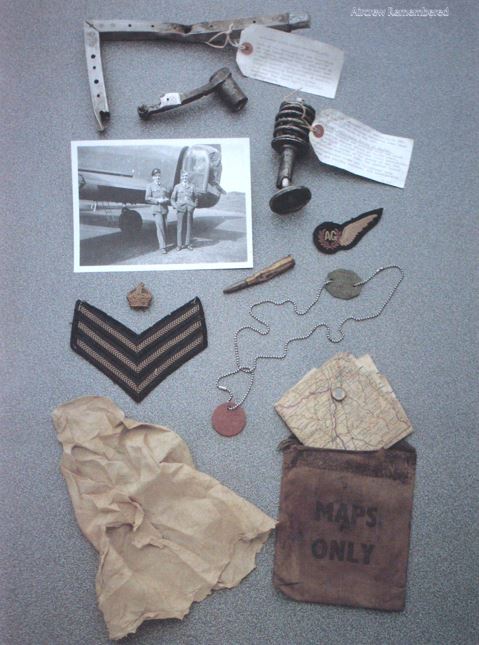Operation: Chemnitz
Date: 5/6 March 1945 (Monday/Tuesday)
Unit: No. 625 Squadron - Motto: We Avenge
Squadron Badge: Within a circular chain of seven links, a Lancaster rose; The Lancaster rose stands for the aircraft used, the seven links the number of personnel in one such aircraft
Type: Lancaster I
Serial: NG240
Code: CF-F2, 'Freddie Firkin'
Base: RAF Kelstern, Lincolnshire
Location: Crashed near Klášterec nad Ohří, Czechoslovakia
Pilot: F/O. James W. 'Jim' Alexander J41173 RCAF Age 20 - PoW (1)
Fl/Eng: Sgt. Clifford Cooper 'Cliff' Lear 1237539 RAFVR Age 22 - PoW (2)
Nav: F/O. William 'Bill' Petrachenko J40408 RCAF Age 23 - PoW (3)
Air/Bmr: F/O. Floyd R. 'Floyd' Chapman J40047 RCAF Age 22 - PoW (4)
W/Op/Air/Gnr: F/Sgt. Graham Wynford 'Wyn' Morgan 1835799 RAFVR Age 20 - PoW (5)
Air/Gnr: Sgt. Robert 'Bob' Pyett 2227268 RAFVR Age 23 - PoW (6)
Air/Gnr: Sgt. Joseph Vivian 'Joe' Williams 1899332 RAFVR Age 22 - PoW (7)
INTRODUCTION
625 SQUADRON
During the Allied Strategic Bombing Offensive against Nazi Germany in World War II (1939-45) 625 Squadron, in its 19 month operational life, was part of No. 12 Base, No. 1 Group Bomber Command. For the majority of this time it was based at, and operated from, R.A.F. Kelstern 5 miles N.W. of Louth, Lincolnshire. During operations,(from the first on 18 October 1943 to the last on 26 May 1945) the Squadron dropped 16,569 tons of bombs and 207tons of food. 74 Lancaster aircraft were lost and 389 Aircrew died.
It is noteworthy that of the seventy-four 625 Squadron losses, only two had all seven crew members bale out to become POWs, LM546 and NG240.
THE CONCEPT OF CREWING UP
Joe Williams in an interview with Kevin Wilson in Journey’s End, provides an invaluable description of the crewing up process and an insight into the significant contribution that it had in enabling the young airmen to face the horrors of nocturnal operational flying, aware that their chance of surviving a tour of thirty ops was a dismal 30%!
'While the details droned beneath smoke-filled rafters crews leaned almost imperceptibly towards both the tell-tale map as if to unlock secrets for a private talisman and also towards each other, drawing recognisable comfort from the unspoken comradeship of those they had joined with random uncertainty at Operational Training Unit and now knew so well. Joe Williams remembers that bond in his own crew of three RCAF officers and four RAF NCOs.
We were all friends and there was no division between us. The Canadians were commissioned, but we were all from the same strata of society. The wonderful thing about it, and it can’t be emphasised enough, was the uniqueness of the crew in the RAF. In every other air force in the world aircrew were told, 'You will fly with so and so.' In the RAF you converged from your different training to OTU where you were going to form up into crews. You were put in a great big building, about 200 of you and then told, 'Get yourselves crewed up.' Now that was a unique experience and you chose each other. You became a crew and friends and each crew was an insular unit. It was a very important way of building morale. You trained together, you flew together and went out at night together. After an operation when you got back and had your breakfast and went to bed, you learned that so and so’s crew didn’t come back and you had to think. There was a distance from them. There was one crew we knew very well, the Cunliffe crew we had known from OTU and they went missing on the first raid to Chemnitz and their captain had bought an old second-hand car. The next morning I saw the RAF police jemmying open the doors and that was the only time I really felt something. They were normally another crew I didn’t know much about. There would be an empty dispersal and the ground mechanics would be left with nothing but the aircraft covers. What happened was the same day a brand-new aircraft would be flown over and later on the nose and the side would have painted on the same letters of the aircraft that had gone missing and a lorry would arrive with another crew. It was a case of 'D for Dog is gone, D for Dog is here'. You kept the name of the aircraft, but personal feelings were diluted because of the insularity of a crew. It was very clever, I think.'
In Bomber Command the crewing up process usually was initiated by the pilot and navigator as they sought to fill the positions of the rest of the crew members, with the exception of the flight engineer who was assigned to the crew on posting to an operational squadron. On occasion it took time for a crew to agree on the choice of flight engineer, who was almost always a member of the Royal Air Force Volunteer Reserve (RAFVR) trained in the UK. This process was simple, effective and straightforward. It allowed a crew to judge for themselves who would give them the best chance of surviving a tour of operations with such horrendous odds. One can only surmise that if crews were assigned by senior officers that the survival statistics would have been even worse and the incidence of LMF much higher than it was.
However, there was an alternate scenario, presented by Ralph Barker, author of ‘The Ship-Busters', that deserves consideration. His perspective was related to the crewing up process for the aircrew of Coastal Command that incorporated the same concept but with a totally different spin. He proposed that the principle motivators to the final crew make up were not the pilot and navigator but rather the two wireless operator/air gunners (W/Op/A.Gs). Here is his rationalisation.
Aircrews arrived at RAF Chivenor, Devon as airmen trained in their independent roles. Pilots had earned their wings and twin-engine endorsements, navigators and wireless operator/air gunners had honed the skills of their trades. The vigorous selection process and survival of the fittest ensured that only the cream of the crop managed to endure to sew on their coveted wings. The selection process, driven by the attrition of warfare, dictated to which RAF Command they were posted to, to start their operational training and tours.
Pilots and navigators had much in common, mixed easily and developed close friendships. However, an external force was essential to complete the crew chemistry. Invariably the catalyst proved to be the W/Op/A.Gs, often less educated and of lower mental age. However, they were not short on shrewdness and native wit, and realised that they had to entrust their lives to others. By this time they had also noticed that there were good aircraft and bad aircraft and in a similar vein, good pilots and bad pilots. It was up to them to choose the crew. During their training courses they had developed a tight bond, were prepared to die for the cause but not unnecessarily. With this in mind they sought out a ‘driver’ who exemplified: steadiness with the appearance of sound, cautious endeavour. In other words, survival trumped heroics. In addition they looked for assurance, complete self-sufficiency and above all, harmony of temperament. Subconsciously they sought out a man with a spark of immortality, one they would care to live with but if required would be prepared to die with.
Thus, unsuspecting pilots and navigators found themselves crewed up. The pilot assumed the role of leader and morale flourished amongst the crew. Out of necessity they became extroverts and realised that nervous tension could not be communicated to his crew mates. Lack of moral fibre in a crew almost always had an anxious pilot as the source.
Taking into account that crews of Bomber and Coastal Command included a pair of gunners in each crew, it is within reason that a similar dynamic was in play during the crewing up process in each. Food for thought.
In retrospect this concept of crewing up was a stroke of absolute genius for the aircrew that were enveloped in a protective cocoon of intimate comradeship that would make them feel invincible when confronted by nightly horrors they encountered over occupied Europe. Not only did this concept link the seven members of a crew but also their families and generations to this day. Aircrew Remembered provides testimony to this wisdom in many archive reports.
A CREW IS FORMED
After signing up at the Brighton Recruiting Centre Joe Williams was assessed suitable for wireless operator/air gunner training (W/Op/AG). After completing the wireless course at 14 Initial Training Wing at RAF Usworth in County Durham due to an abundance of W/Op/AGs he was invited to be a plain air gunner. At Gunnery Initial Training Wing, RAF Bridgnorth in Shropshire he again graduated top of course. A posting to 7 Air Gunnery School at RAF Stormy Down South Wales, introduced him to the harsh reality of aircrew training when two Ansons collided on his first morning: fatal for two pilots, two instructors and six students! On 23 June 1944, he completed his gunnery training as Sergeant Williams.
His next posting was to 18 Operational Training Unit at RAF Finningley in the West Riding of Yorkshire and its satellite, RAF Scofton in Nottinghamshire. Here he crewed up with pilot, Jim Alexander, a farmer’s son from Norwich, Ontario, and fellow Ontarians, Bill Petrachenko, navigator, and Floyd Chapman, bomb aimer. Their Wellington X crew was completed with wireless operator, Wyn Morgan of Swansea and a second gunner, Wally Walford. By 27 September they were posted to 1662 Heavy Conversion Unit at RAF Blyton in Lincolnshire which was equipped with Halifax IIs, and where flight engineer, Cliff Lear of Nottingham, joined them to round off their combat team. After conversion training there followed a stint at No. 1 Lancaster Finishing School at RAF Hemswell also in Lincolnshire.
On 21 November 1944, F/O J.W. Alexander and crew, with P/O. George Walford as MUG, now deemed duly prepared and ready to start their operational tour, were posted to 625 Squadron at RAF Kelstern.
OPERATIONS
On December 4, 1944 F/O. Alexander was introduced to the grim reality of combat flying as ‘second dicky’ of the crew of F/O. K. L. Trent DFC for an uneventful raid on Karlsruhe. This hybrid crew included F/O Floyd R. Chapman and Sgts. Clifford Cooper Lear and Joseph Vivian Williams.
F/O. Alexander and his core crew made uneventful trips to Merseburg-Leuna and Essen on 6 and 12 December 1944, respectively. On both these operations and the remainder of the tour, the crew included Sgt. Robert Pyett manning the mid-upper turret. For reasons unknown, P/O. George Walford, never returned to this crew.
The Battle Order for 15 December 1944 detailed the Alexander crew to bomb Ludwigshafen. F/Sgt. J.N. Wadsworth was a spare bod air bomber for this op.
On 17 December 1944 they returned safely from a trip to Ulm. Their next mission to Bonn on 21 December 1944, with F/Sgt. P. Cooney as bomb aimer was uneventful until their return to England. Of the twenty-four 625 Squadron Lancs, twenty-three had to divert, ten to Hemswell, nine to Fiskerton and four to Ludford. Only PB375 with F/L. L.F. Spooner at the controls was able to make an early return to Kelstern, due to an incapacitated wireless operator fourteen minutes into the flight, with a total air time of sixteen minutes!
F/O. Alexander and crew finished the year with two rapid succession ops to Mönchengladbach and Gelsenkirchen - Buer on 28 and 29 December 1944, respectively.
They started the New Year with a successful trip to Nuremberg on 2 January 1945.
For their next two ops on 6 and 7 January 1945 to Hanau and Munich this crew required replacement air bombers, F/O. D. H. Crowther and F/O. G.C. Davies. For the remainder of their operational tour, this tight knit crew would not be dependent on spare bods. The remainder of their ops would be uneventful until the final one:
1 February 1945, NG240 to Ludwigshafen, 2 February 1945, NG240 to Wiesbaden (Op No. 13 Jinx),
7 February 1945, NG240 to Cleve, 8 February 1945, NG240 to Politz,
13 February 1945, NG240 to Dresden
On arriving over Dresden, it was obvious that it had been transformed into an inferno, never seen before. After releasing their bomb load, departing the target, the bomb aimer discovered that the ‘Cookie’ had hung up. Sgt. Williams in the rear turret, noting absence of flak suggested a go around. After a brief exchange with Skipper Alexander and a not so subtle rebuke, he ordered the wireless operator to release the ‘Cookie’, bomb rack and all. Ten miles from the target there was a massive explosion and fire that was visible 180 miles from the target as a distinct miniature glow. One can only wonder what the wayward ‘Cookie’ took out.
14 February 1945, PA175 to Chemnitz, 20 February 1945, NG240 to Dortmund and a daylight raid to Cologne on 2 March 1945 in NG240.
REASON FOR LOSS
5 March 1945. NG240 F/O J.W. Alexander and crew, Take-off - 16.39 - CHEMNITZ. Failed to return. No news after take-off.
Nachtjagd War Diaries Volume Two attributes the loss of NG240 to:
Hptm. Ernst-Georg Drünkler: 31 1.NJG5 4-mot S.E. Zwickau 22.05 poss. 425 Sqn Halifax PN173, 625 Sqn Lanc. NG240 or 625 Sqn Lanc. PB375
Theo Boiten and Rod MacKenzie are in the process of publishing the expanded Nachtjagd Combat Archive (NCA), comprising fifteen volumes, with a projected completion date of late 2021 to early 2022. This includes two additional volumes on the Med and Eastern Front Nachtjagd.
A lifelong mega-project that is eagerly anticipated by historical aviation enthusiasts. The trojan task of expanding the two volume Nachtjagd War Diaries into the fifteen volumes of the Nachtjagd Combat Archives has been monumental and painstaking, their research diligent and unbiased. They have both been most gracious with their time and energy in responding to our numerous queries researching loss causes of numerous 625 Squadron Lancs and their crews.
Hopefully the pending volume to cover the March 5/6, 1945 Chemnitz raid will include a definitive claimant for the loss of NG240.
THE CHOP
The night before the Chemnitz raid, Sgt. Joe Williams participated in a most serendipitous pub crawl with his crew at the Waterloo Arms in Laceby. The officers including Jim Alexander, the Squadron Commander, ‘C’ Flight Commander and Station MO pitched in a pound to the NCOs ten bob (50p). A sequence of brown ale and whisky chasers soon had all concerned in a state of blissful intoxication. In the course of disjointed conversation Joe heard mention of a spare parachute in their aircraft. On querying its location, someone informed him that it was behind the pilot’s seat. Fortunately, they were all amnestic for the 13 mile trip back to Base, with Bill Petrachenko at the wheel, as a novice driver.
The two pronged attack of March 5/6 1945, included 760 aircraft attacking Chemnitz and 258 attacking Böhlen. This was a continuation of Operation Thunderclap that the Russians had requested at the Yalta Conference of February 4, 1945 and was supported by Winston Churchill. The intent was to bomb the Germans into surrender by targeting the cities of Dresden, Chemnitz and Leipzig. It was on this evening, participating in the Chemnitz raid, that seven Halifaxes succumbed to severe airframe icing before clearing the English coast, without a shot fired. See Addendum on archive report JB122
The Squadron ORB provides the following summary for this raid that would have a major impact on two of the participating crews:
5 March 1945 Chemnitz was the target for a night attack in which 21 aircraft from this Squadron took part, but due to 10/10ths cloud conditions in the target area, no results of the bombing were observed. From the aircrews point of view this was a poor and uninteresting trip.
Several combats were seen and large glows could be seen through the clouds on the way back. “F2” (F/O J. ALEXANDER) and “R” (F/L A.D. COOK) failed to return to Base.
The Squadron’s Lancs departed Kelstern in twenty-nine minutes, between 16.16 and 16.45. F/L Cook was twelfth off in PD375 at 16.36 and F/O Alexander, fifteenth at 16.39. As they lifted off into the gathering dusk with Sgt. Lear’s left hand covering his Skipper’s right to prevent throttle slippage, little did they realise that their twentieth op would be a one way trip.
This raid commenced with bad vibes for F/O Alexander and the crew of NG240. It would not take long for them to discover that Lady Luck had removed her protective cloak.
Outbound over the landmark of Beachy Head, Cliff Lear observed smoke pouring out of the starboard outer engine. His impression was it had digested a cylinder head gasket. The decision was made to shut it down and feather the prop. This engine ran a generator that provided hydraulic power to the mid-upper turret and a navigational aid. At this point Jim Alexander had a crew conference to evaluate the risk of continuing the mission on three engines, with the prospect of restarting the delinquent engine to climb to bombing height.
After reassurance from the rear gunner that he could manage a lookout for night fighters, the navigator that he could provide accurate fixes and the flight engineer that they would have sufficient fuel to make back to English soil, albeit with a landing in the south — Jim Alexander elected to continue with the op. One can only think that being labelled 'Lack of Moral Fibre'. LMF was a significant factor in his decision to press on regardless.
The planned restart of the starboard outer did not go well. It immediately burst into flames necessitating activation of the Graviner system that flooded the engine compartment with foam, dousing the fire. The die was cast, they would bomb the target as detailed, on three engines from a lower altitude!
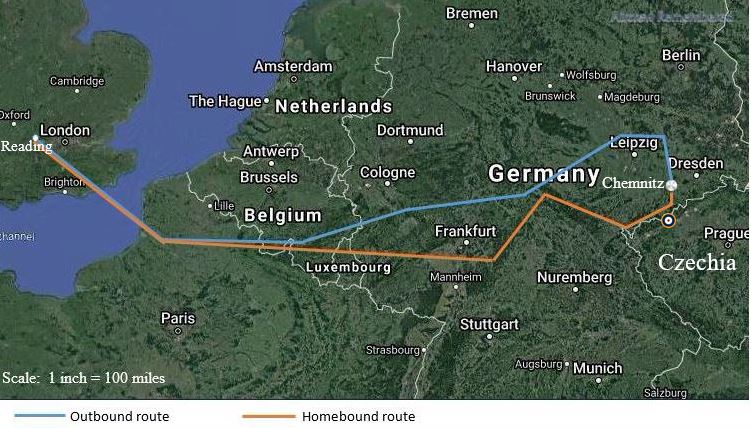
Late over target, they anticipated that the flak gunners would not be expecting them and the night fighters would be landing to refuel. Such was not the case. After releasing their bomb load and exiting the target area, Joe Williams, in the rear turret, spotted a Ju 88 night fighter silhouetted in the target fires, approaching from the starboard quarter down. He directed Jim Alexander to initiate a gentle turn to port to see if the fighter had established visual contact. It shadowed them in the turn and closed rapidly to attack. Joe Williams then requested flat turns and opened fire. With reduced airspeed and manoeuvrability they did not stand a chance. Despite an obtunded corkscrew manoeuver the night fighter managed to tuck in beneath them for a classic schräge music attack, riddling them from stem to stern with cannon fire. Bob Pyett in the mid-upper turret heard the 20mm rounds as they pounded down the fuselage. With both wings on fire, Jim Alexander gave the order to bale out.
For Joe Williams in the rear turret, the situation unravelled. With sheets of flame streaming down the fuselage he had lost power and intercom, his turret was burning and one of the doors had jammed, trapping him inside. After a brief prayer and one last desperate attempt he was able to escape his turret to face a tunnel of flame in the fuselage and his parachute pack burning up in its stowage. Almost instantly he recollected that a spare chute was stored behind the pilot’s seat.
Unfortunately, in his haste to escape his turret, he erred in removing his oxygen mask. Traversing the inferno inside the fuselage as he moved forward towards the cockpit, he sustained burns to his face, knees and seat of his Sidcot flying suit and the right-hand side of his parachute harness.
On reaching the cockpit he realised that the crew had baled out, with the exception of the pilot who was preparing to depart through the nose hatch. After a brief discussion which included a suggestion that they might jump together on one parachute, cooler heads prevailed and they decided to track down the wayward spare chute.
MANY YEARS AFTER THE WAR JIM ALEXANDER RELATED TO JOE WILLIAMS THAT WHAT HE DID NEXT WAS THE BRAVEST THING HE EVER DID IN HIS LIFE.
Rather than abandon his crew mate, Jim Alexander climbed back into the pilot’s seat of the doomed NG240, to regain control. This allowed time for Sgt. Williams after a desperate search to locate the spare chute stowed under the navigator’s table. At this point Joe glanced out at the port wing to see blue flames of burning petrol spurting out of the wing. Wasting little time, he dived through the nose hatch, pulled the ripcord, and felt a reassuring tug on his shoulders. Jim was not far behind!
It is noteworthy that Bob Pyett had a similar experience when he dropped from his turret into the inferno that was consuming the fuselage interior. In desperation he dived through the rear door, pulling his ripcord as he exited— only to have the slipstream force him back inside with his chute deployed in a bundle of silk around him. Nonplussed, he gathered the billowing chute in both arms, sat with his back to the rear door and rolled backwards into the night. Passing beneath the starboard tailplane, he opened his arms and was rewarded with a pleasant jolt as his chute deployed.
Incredibly, all seven of F/O. Jim Alexander's crew survived the bale out to become POWs.
While descending, Joe Williams was assessing his facial burns when he impacted on the back of his head, landing in snow, approximately 10 to 15 miles into Czechoslovakia. After a short hike down the Ore Mountains in darkness he had the unique distiction of surrendering to a man sitting on an outdoor toilet! The Sudeten German farmer and his two daughters provided first aid to his burns and then called the Volksturm. He was taken to the local police station and the next day to the town of Kaaden where he was detained. By this time his eyes were swollen and crusted closed as a result of his burns. His burns would eventually heal but as a result he would have brown facial discolouration for the next three years as a memento.
He was reunited in the Kaaden cell with his fellow gunner, Bob Pyett. Bob had landed in a large tree and managed to safely extricate himself. Wisely, he discarded the .38 pistol that he had concealed in his flying boot. He was captured the day after they were shot down.
Eventually both gunners were taken with other prisoners to the Dulag Luft interrogation centre near Frankfurt. On April 4 they were moved to Stalag Luft XIIID near Nuremberg. The next day, while being evacuated with 300 other prisoners, Joe managed to escape with his Canadian navigator, F/O. Bill Petrachenko. After several hair-raising days on the run, in the midst of the chaotic final days of the Third Reich, they found freedom, reaching American lines on April 10, 1945. This brief interlude was quite likely the most dangerous time in their operational careers! (See also ND571).
Sgt. Joe Williams’ family was not expecting his unannounced homecoming. They had received the telegram stating that he was missing on operations and did not know if he was still alive. On the day of his arrival home, a member of the RAF had contacted his mother to inform her that he had been in a camp and was safe. On arrival by train at Isfield, the Station Inn's landlord's wife, Mrs Pullinger, loaned Joe their car for the two mile drive to the family farm. After embracing his mother, he walked out to the field where his father and elder brother were spreading manure. 'There was simply relief that I was home and we just shook hands.'
For the Williams family, the was over — their boy was home.
An extended version of the above story can be heard in an interview with Joseph Williams available on the Imperial War Museum website. To listen to the interview click here
LOSS CARD - NG240
Front
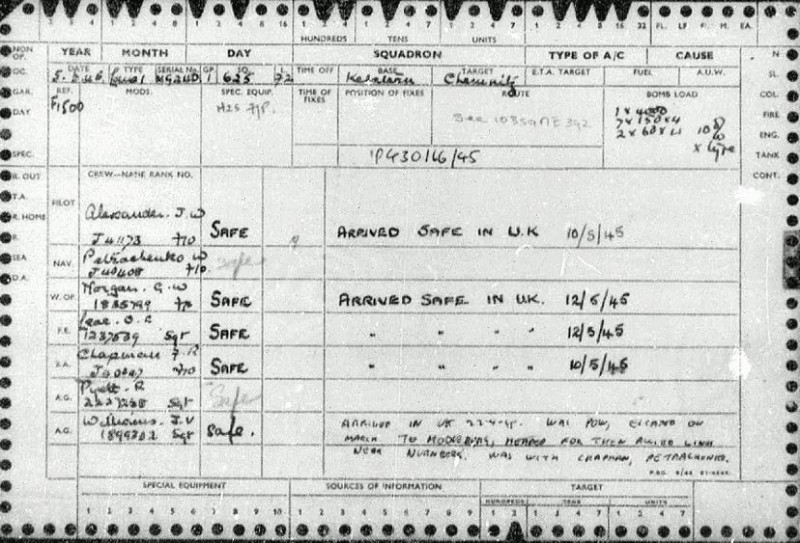
Additional details from the above loss card
Special Equipment – H2S and Fishpond (see abbreviations)
Bomb Load – 1 x 4000lb 7 x 150 x4lb [clusters] 2 x 60 x 4lb Incendiaries including 10% ‘X’ type
Against Joe Williams’ name – Arrived in UK 22 . 4 . 45 Was POW. Escaped on march to Mooseberg Headed for Allied Lines near Nurnberg. Was with Chapman and Petrachenko
Reverse
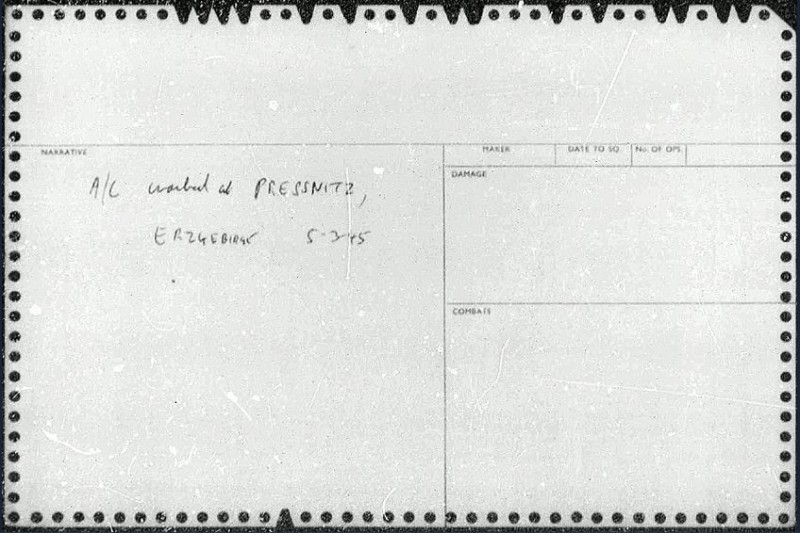
BIOGRAPHICAL DETAILS OF THE CREW
1. F/O James W. Alexander - nothing further known, if you have any information please contact our helpdesk
2. Sgt Clifford Cooper Lear was born in 1923 at Nottingham the son of Arthur C Lear and Nellie M Lear nee Cooper. He had one sibling, Philip A. C. Lear born 1920.
In 1939 the family lived at 75 Edgeware Road, Nottingham. At the time Arthur C. Lear was a Lieutenant in the National Defence Company at Nottingham.
In 1960 he married Dorothy M Bloom at Nottingham.
3. F/O William Petrachenko was born on 19 September 1921 at Crowland, Ontario Canada. He had five siblings: Walter Petrachenko, Ann Petrachenko, Olga Petrachenko, Nick Petrachenko and Steve Petrachenko
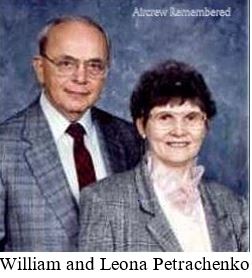
In 1946 he married Leona with whom he had four children.
After the war he practiced optometry in Welland and St. Catharines, Ontario for 42 years.
He showed keen interest in the visual problems of children and was chairman of the Children's Vision Committee of the Ontario Association of Optometrists. In 1952, he was accepted as Fellow of the American Academy of Optometry (FAAO). He served as member of the Welland Board of Education for 4 years and also as a member of the Ontario Research Committee of the Association for Mentally Retarded.
He died at Welland Hospital on 1 December 2001 aged 82 and was buried at Fonthill Cemetery, Fonthill, Niagara Regional Municipality, Ontario, Canada.
4. F/O Floyd R. Chapman - probably born in 1921 the son of Chester G. Chapman and Barbara J. Chapman
He died in 2001 (aged 79–80) and was buried at Woodland Cemetery, Hamilton, Hamilton Municipality, Ontario, Canada
5. Fl/Sgt. Graham Wynford Morgan was born 13 February 1925 at Ynysforgan, Swansea, Glamorgan Wales the son of Handel Morgan (a Tin Plate Roller Man) and Elizabeth Morgan nee Lewis. He had one sibling, Averil Deborah Morgan (1919-2001).
In 1939 the family lived at 8 Bryn Terrace, Ynysforgan.
Graham Morgan married Nancy Evans at Swansea in 1949. They later had three children
He died on 5 May 1968 at Clydach, Glamorgan, Wales
6. Sgt. Robert Pyett was born on 30 September 1921 at Chapel en le Frith, Derbyshire the son of John Armstrong Pyett (a Lime-burning and Quarrying Labourer) and Edna Pyett nee Mycock. He had one sibling, Mary Pyett born 1920.
In 1939 the family lived at "Eddistone" Burlow Road, Buxton, Derbyshire. At that time Robert Pyett was employed as a Lime-burning and Quarrying Weigh Clerk.
In 1946 he married Jemima Cunningham at Chapel en le Frith.
Robert Pyett died on 7 November 2002 at Salford, Lancashire aged 81
7. Sgt. Joseph Vivian Williams was born 31 May 1922 probably at Bradford on Avon, Somerset the son of Frederick C. Williams and Mary E.A Williams nee Jones. It is believed that he had a twin brother Ralph V. Williams.
Joe Williams worked on the family farm at Little Buckham Hill, Sussex. His father had served with distinction in the Royal Canadian Horse Artillery. 17 year old Joe, in 1939, was intent on following in his father’s footsteps “to do his bit”, but was thwarted by the County Labour Officer, as his farming efforts constituted a Reserved Occupation. But in September 1943 having volunteered for air crew and signed up at Brighton Recruiting Centre. The details of his training and operational training are included in the introduction,
After escape and evasion, Sgt. Williams returned to 625 Squadron and remustered as a Flight Mechanic E (Engines). On 14 January 1946 he was demobbed and returned to the family farm.
Following his return to the UK Joe received notification of promotion having served for 12 months. Assuming the promotion was to Flight Sergeant Joe was surprised to learn, much later in 1993, that he had been promoted two ranks to Warrant Officer. We can only surmise that this was a merit promotion as the result of ‘pressing on’ to carry out the sortie and his subsequent escape from captivity.
In 1947 he married Doris F. Barton at Uckfield in Sussex.
In 1963 he was employed in grain management in Devon, progressed to the South-West Farmers Agricultural co-operative and finally to the Mole Avon co-operative.
Joe’s son became an RAF pilot.
Joseph Williams died at Exeter, Devon on 28 March 2016 aged 93
Joe was a very active Chairman of the Exmouth and District Branch of The Aircrew Association. He was instrumental in the erection of a memorial cairn at the symbolic landmark of Beachy Head, commemorating NG240 and the Bomber Crew airmen who departed, outbound overhead — never to return.
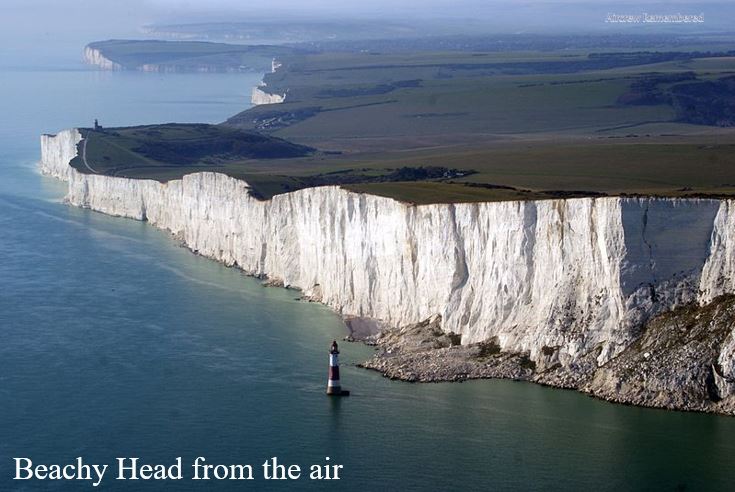
Bomber Command Memorial Beachy Head

Photo © David Dixon (cc-by-sa/2.0)
The inscription read
WORLD WAR II 1939 TO 1945
BEACHY HEAD WAS THE MAJOR OPERATIONAL ROUTE OUTBOUND FROM
THE UNITED KINGDOM FOR THE AIRMEN OF THE ROYAL AIR FORCE
BOMBER COMMAND, WHEN TAKING THE WAR TO THE ENEMY
THEY FOUGHT IN THE SKIES ABOVE THE ENEMY
AND PAID THE TERRIBLE PRICE THAT WAR DEMANDS
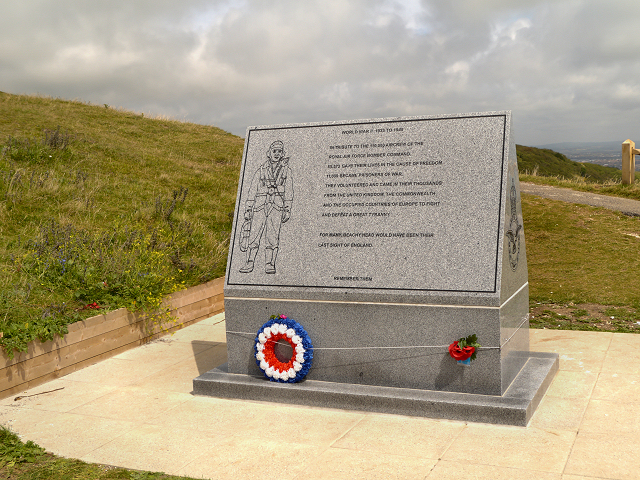
Photo © David Dixon (cc-by-sa/2.0)
The inscription reads
WORLD WAR II 1939-1945
IN TRIBUTE TO THE 110,000 AIRCREW OF THE
ROYAL AIR FORCE BOMBER COMMAND
55,573 GAVE THEIR LIVES IN THE CAUSE OF FREEDOM
11,000 BECAME PRISONERS OF WAR
THEY VOLUNTEERED AND CAME IN THEIR THOUSANDS
FROM THE UNITED KINGDOM, THE COMMONWEALTH
AND THE OCCUPIED COUNTRIES OF EUROPE TO FIGHT
AND DEFEAT A GREAT TYRANNY
FOR MANY, BEACHY HEAD WOULD HAVE BEEN THEIR
LAST SIGHT OF ENGLAND
REMEMBER THEM
In 2007 Joe Williams along with Nic Lewis, at the time, Honorary Secretary of the 625 Squadron Association compiled a nostalgic CD, A TRIBUTE TO BOMBER COMMAND. It includes a series of eleven tracks of topical poetry and vignettes, punctuated by the crescendo roar of four Merlins at maximum take-off boost. For the enthusiasts, Track 10: Lancaster Montage consists of six minutes and forty-six seconds of the latter. To listen to this track see archive report for LM513 Addendum - The Lancaster
Other tracks from this CD are included in the following Aircrew Remembered archive reports:
Track 6: Introduction to Battle Order - PB413,
Track 1: Lie In The Dark And Listen - ED377
Others will be added with future archive reports.
The CD information pamphlet includes additional details of the fateful flight of NG240, CF-F2, AKA Freddie Firkin.
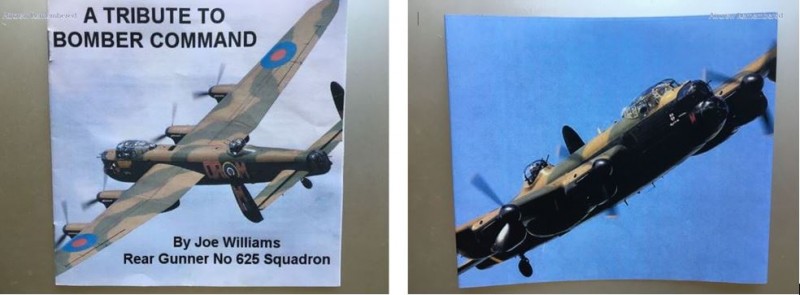
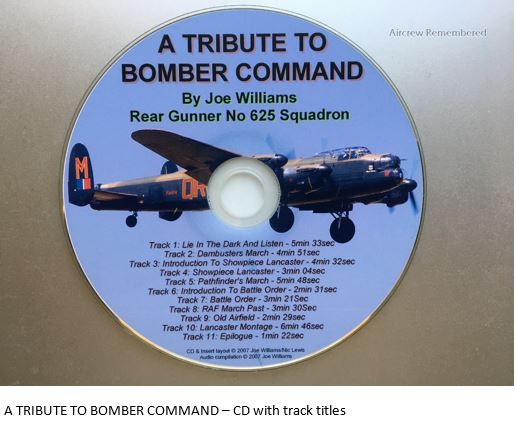
Many years after the war Joe Williams was reunited with the two girls he met that night, after they traced him through an RAF magazine and accepted his invitation to visit him and his family in Devon.
In August 1981, Joe, his wife Doris, son Clinton and Bill Petrachenko, retraced their escape route. They located what was thought to be the crash site of Fox-2. However, aircraft fragments recovered suggested that this was site of a German fighter’s demise.
Joe was also able to reunite with the Sudeten-German family that he had first encountered, who showed him the large tree, a small bush at the time, where he had concealed his parachute.
Joe was notified by Czech journalists in 1987 that the actual crash site of Fox-2 had been located. Later that year aircraft fragments were recovered from the site and are on display at the Czech National Air Museum in Prague — in memoriam of an aircraft and crew that left their mark so many years ago.
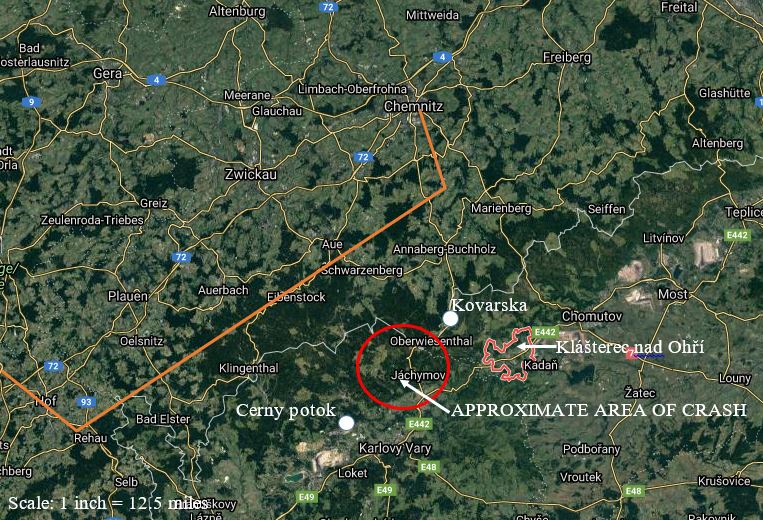
A REUNION WITH FREDDIE FIRKIN
Details and photographs by kind permission of Jan Zdiarsky

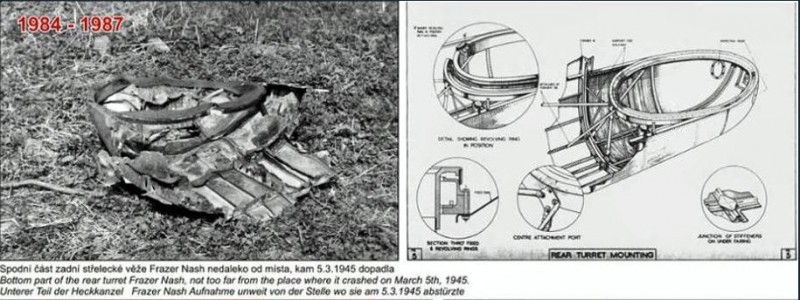
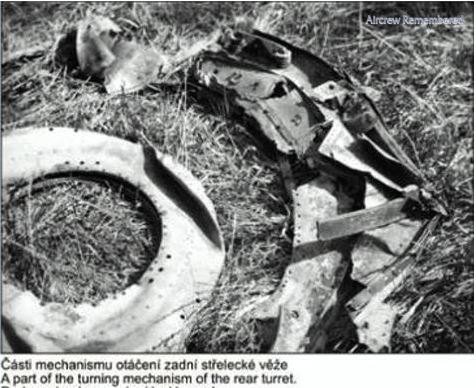
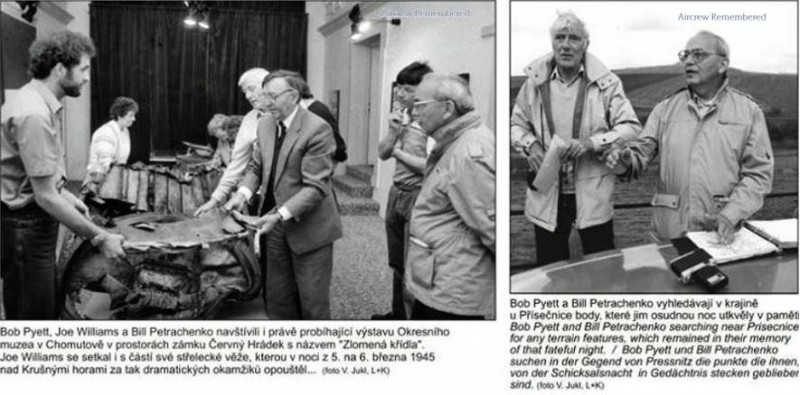
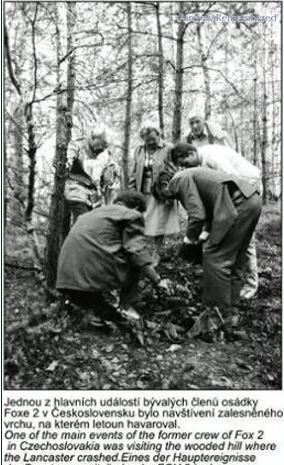
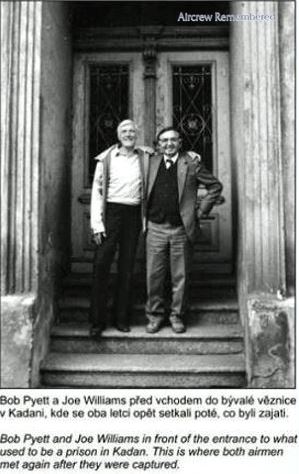

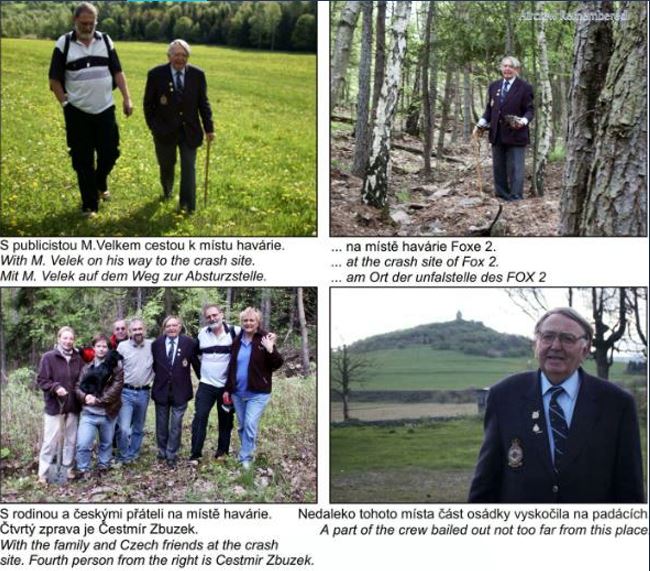
BURIAL DETAILS
Nil: All the crew members survived.
DECORATION SUGGESTIONS
J41173 F/O J.W. Alexander - VC, Text above and Author’s Notes below
1237539 Sgt. C. Lear - DFM, PoW
J40047 F/O F.R. Chapman - DFC, POW and Evader
J40408 F/O W. Petrachenko - DFC, POW and Evader
1835799 F/Sgt. G.W. Morgan - DFM, POW
2227268 Sgt. R. Pyett - DFM, POW
1899332 Sgt. J.V. Williams - DFM, POW and Evader
Author’s Notes
F/O Jim Alexander and the crew of NG240 exemplify the tight bond, comradeship and team-work that were essential for survival in the futile combat situation in which they found themselves. This experienced crew was on their twentieth operation when Lady Luck decided to remove her protective cloak sufficiently to prevent them from returning to base. However, serendipitous propinquity resulted in all seven surviving the determined attack by a Nachtjagd expertin.
This crew had two opportunities to abort the mission. The first occurred before they had cleared the English coast when the starboard outer engine showed signs of an imminent fire or outright failure. After shutting down and feathering the prop and obtaining feed-back from significant crew members of the impact on their combat status, Jim Alexander elected to press on. At this point they had grounds to return to base. However, one has to consider the real threat of being labelled 'Lack of Moral Fibre' (LMF) and the consequences. With this in mind it is not difficult to understand the decision to press on. However, when the delinquent engine caught fire with the restart, the die was cast. Nearing the target, reduced to three engines, made it much more difficult for Jim to abort. As a result they were last over the target, at a lower altitude and reduced airspeed and manoeuvrability to ward off a night fighter attack. In retrospect, this was the point at which the decision to return to base could not have been contested by Senior Staff.
Despite this crew's experience and discipline, they did not stand a chance when engaged by Hptm. Drünkler. The standard ‘corkscrew’ manoeuver was ineffective. Bomb aimer, Floyd Chapman, provided testimony to this crew’s combat teamwork when he witnessed their opponent deliver the final blow with a classic schräge musik attack, during their final, desperate, evasive manoeuvers. At this point there could be only one outcome.
As the final moments of NG240’s lifespan unravelled, the fates of Jim Alexander and Joe Williams hung in the balance of one man. Realising that Sgt. Williams was without his chute, Jim Alexander, aware that NG240 could explode at any moment, without hesitation, returned to his controls and directed Sgt. Williams to the spare chute. Only after Sgt. Williams had safely baled out did F/O Alexander follow suit. This courageous act is on par with that of P/O Andrew Mynarski that earned him a posthumous VC. Two other 625 Squadron pilot’s displayed comparable acts of valour but were not recognised for their actions: Canadian F/O. Lloyd Hannah and American 1st Lt. Max Dowden
The author feels that their actions were just as much deserving of a VC as noted in the respective archive reports.
It will be interesting to see if Theo Boiten is able to shed more light on the Nachtjagd pilot who claimed the victory for NG240 and identify the pilot and crew of the night fighter that crashed in the same vicinity on the same night. If this proves to be the case, it would be quite convincing that Joe Williams would have been the victorious gunner. This would not be the first time that a sharp eyed mid-upper or rear gunner was responsible for the fate of their attacker.
In retrospect, F/O Alexander and his crew could not be faulted for their decision making processes up until they attempted to restart the delinquent starboard outer engine. At this point no senior officer could have accused them of LMF. They pressed on despite the odds being stacked against them, reduced to the handicap of three engines and being late over the target. They would have anticipated that by this late hour the majority of night fighters would be forced back to their airfields, low on fuel. One can only speculate on how many crews made the same decision with similar serviceability handicaps and failed to return but without survivors to give testimony to their heroics. The price paid to avoid being labelled—LMF!
JEA.
REFERENCES:
Journey’s End by Kevin Wilson.
Museum of Air Battle over the Ore Mountains on September 11th 1944.
A TRIBUTE TO BOMBER COMMAND by Joe Williams, Rear Gunner No. 625
Squadron, CD and Information Pamphlet.
625 Squadron ORB
Nachtjagd War Diaries Volume Two by Theo Boiten and Rod McKenzie.
The Bomber Command War Diaries by Martin Middlebrook and Chris Everitt.
Jan Zdiarsky, Museum of Air Battle over the Ore Mountains.
René Schütz, Vermisstenforchung (Research of the Missing).
CO-AUTHORS:
John Naylor
Maureen Hicks
Reg Price
Roy Wilcock
PHOTO CREDITS:
A TRIBUTE TO BOMBER COMMAND
Jan Zdiarsky
AUDIO CREDITS:
A TRIBUTE TO BOMBER COMMAND, Track 10: Lancaster Montage
Submission by Jack Albrecht and Nic Lewis, co-producer of A TRIBUTE TO BOMBER COMMAND. In memory of W/O Joseph Vivian Williams. April 2020
JEA/RW 26.04.2020
